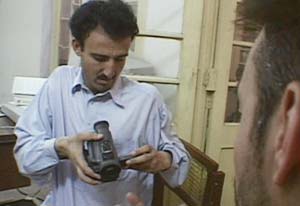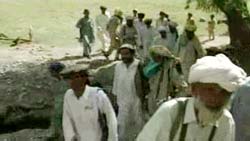Pakistani journalist and FRONTLINE contributor Hayat Ullah Khan lived in Pakistan's tribal area and worked as a freelancer for Western media. He recognized the dangers in reporting what was happening in this region and the risks he faced revealing things that sometimes were embarrassing for his government. Here's the story of his life and death.

Hayat Ullah Khan in 2002.

Hayat's Video: Inside the Tribal Areas
(9:30) Hayat Ullah Khan shot and narrated this video for FRONTLINE producers Martin Smith and Marcela Gaviria when they were making their 2002 documentary "In Search of Al Qaeda." In these Web-exclusive excerpts, he documents a traditional Pashtun meeting of elders, known as a loya jirga. He visits abandoned refugee camps, which until recently, had been teeming with some of the tens of thousands of Afghans displaced by decades of war. And he has a close call -- driving over a mountain pass. Khan witnesses a family dispute being settled the traditional, tribal way -- with guns. He also finds evidence of Western influence in the region: a cricket match played by Pashtun tribesmen, and a local music store selling CDs from American artists.
Pakistani investigative journalist Hayat Ullah Khan knew well the challenges in reporting from the region. Reporting from Afghanistan after the U.S. invasion, he was questioned for several days by U.S. special forces on suspicion of links to Al Qaeda. Another time, he was accused by Pakistani tribal police of being an American informer. "I tell them I am an informer," he later recalled, smiling. "I am a journalist. I inform America with my reporting. But also the whole world. I am an informer. You are right."
FRONTLINE producer Martin Smith met Hayat Ullah while reporting a 2002 documentary, "In Search of Al Qaeda," which followed the trail of the hundreds of Al Qaeda fighters who survived U.S. airstrikes and fled the mountains of Afghanistan to the borderlands of Pakistan, across the Gulf of Oman, to Saudi Arabia and Yemen. Smith and his co-producer Marcela Gaviria hired Hayat Ullah to film in Pakistan's tribal areas south of Peshawar, strictly off limits to foreigners. "Hayat was a dedicated journalist who gave outsiders some of the first glimpses of Waziristan," recalls Smith. "From the moment we met him, we recognized his intelligence and talent."
On Dec. 5, 2005, Hayat Ullah was riding in a car with his brother when he was abducted by unknown assailants. Four days earlier, in Mir Ali, North Waziristan, he had taken photos of the aftermath of what Pakistani officials had said was an accidental bomb-making explosion that killed Abu Hamza Rabia, an Egyptian believed to be a senior Al Qaeda operative. Hayat Ullah's photos, which showed clearly identifiable fragments of U.S. Hellfire missiles in the rubble, directly contradicted the government's story.
Though no one knows who kidnapped Hayat Ullah, his family suspects the government: "We believe that the government is involved in the kidnapping of Hayat Ullah because Hayat said to my mother, 'When I published the pictures of the guided missile, that I know that the government will harm me,'" his brother, Haseen Ullah, explained to FRONTLINE.
Interviewed on June 8, 2006, Pakistani President Pervez Musharraf flatly denied that Hayat Ullah was in Pakistani custody.
Eight days later, Hayat Ullah's body was found in a ditch near his home village of Mir Ali; there were five bullet holes in his head and his wrists were bound with government-issue handcuffs. The government promised investigations, two of which were delivered to Islamabad in late summer 2006. As of September 2006, neither report has been released.
Hayat Ullah is one of nine journalists killed in Pakistan in the last four years, and the third to be killed in the tribal areas. "It's a great risk for the local journalists who have to live in that area, who are under pressure from every side -- from the military, from the political authorities and from the militants," Rahimullah Yusufzai, a veteran BBC correspondent recognized as the "dean" of the tribal area reporters, explained to FRONTLINE. Yusufzai, like many Pakistani reporters, lives outside the region. "It's really much easier for people like us to go there and report," he says. "… But we can't go there every day or every week. We just go there for a major event. So I think that is … a disadvantage because there cannot be actual on-the-spot reporting of what is happening in Waziristan."
Both the Committee to Protect Journalists and Reporters Without Borders have raised concerns with Pakistan's government about the dangers facing journalists in the country, dangers of which Hayat Ullah was well aware. His work with foreign journalists allowed him to earn enough money to pursue a very different dream -- in March 2005, he completed construction of the independent Al-Hayat Middle School for boys and girls in the village of Jangal Khel in North Waziristan.
"I have spent more than $60,000 on the school for one purpose," he wrote FRONTLINE producers Smith and Gaviria, "to change the most backward area of people's lives." He continued:
Initially, many people discouraged me, saying that the local tribespeople were extremely backward and religious minded and already had Islamist madrassas in the area to educate their children. Thus the people criticized the co-education English middle school and started propaganda that the school was supported by America. However, I did not buy the argument and proved them wrong.
As the school progressed, the local communities also joined hands and encouraged their children to get enrolled. Today, the number of students has risen to 220, including 10 female students.
Hayat Ullah's school, which charged those who could afford it $1 per month in tuition, also provided transportation and health care for the children, and media coverage of his efforts led the government to introduce electricity and telephone services into the region.
"He was doing on his own -- he raised the money himself -- exactly what it is the United States government and the West says is the most important thing to do in that area; that is, to provide some sort of alternative education," says Smith. "So it's a double tragedy that this guy, who was talking about getting out of journalism, because of the risks, and dedicating himself to education, would disappear and turn up dead like this."
According to the Committee to Protect Journalists, the local village took over the school after Hayat Ullah's death. It currently has about 150 students, including 15 girls.
Update: In December 2006, the Pakistan Press Foundation with support of the United Nations Educational, Scientific and Cultural Organization (UNESCO) conferred on Hayatullah Khan posthumously the PPF-Aslam Ali Press Freedom Award, in recognition of his contributions and sacrifices for press freedom. Also in 2006, Hayat Ullah was honored posthumously with an International Press Freedom Award given by the Canadian Journalists for Free Expression. Each year this award is given to recognize journalists around the world who were persecuted because of their work.
- Related Links
- Into Thin Air
In this essay, published in Slate before news of Hayat Ullah's death, journalist Eliza Griswold recalls her friend and wonders about his fate. [March 30, 2006] - Pakistani Officials Pledge Review of Journalist Killings
The Committee to Protect Journalists published this report with recommendations for Pakistan's government to ensure press freedom. It also includes a detailed list of the deaths, detentions and assaults against journalists in the country. [July 27, 2006]